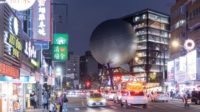Berkeley, California
Of the many neoclassical buildings that architect John Galen Howard designed for the University of California, Berkeley, in the early twentieth century, California Memorial Stadium was perhaps the most breathtaking and the most imperiled: from its perch at the base of the Berkeley foothills, the concrete structure—part coliseum, part amphitheater dug into the hillside—offered 73,000 Golden Bears fans sweeping views of San Francisco Bay to the west, but on a site straddling the Hayward Fault.
After the University of California's Board of Regents mandated a much-needed seismic revamp in 2005, the university enlisted HNTB Architecture and STUDIOS Architecture to overhaul the 1923 structure, which is listed on the National Register of Historic Places. It was a tall order: designers needed to make the stadium safe and boost square footage by 50 percent. However, they were not permitted to interfere with the historic board-formed-concrete facade. In other words, the university wanted an entirely new building, but without altering the original.
The architects found the solution to this Zen koan of a design brief in the site's slope, much as Howard had 90 years ago. Beginning construction in 2010, they hid a 145,000-square-foot athletic training center largely underground, disguising it behind a series of concentric retaining walls made out of volcanic rock, limestone, and concrete. They demolished the western two-thirds of the old structure—everything but the portion built into the hillside and the facade—and inserted a new eight-story building, including three donor clubhouses, into the original footprint. With the help of Forell/Elsesser Engineers, the team designed the poured-in-place concrete structure (with precast seating platforms in the bowl) in two halves along the fault line, which traces a roughly north-south diagonal from one end zone to the other. For the parts of the bowl directly over the fault, the engineers conceived a pair of wedge-shaped seating sections that can slide up to six feet horizontally and two feet vertically during a powerful quake [see RECORD, January 2009, page 112]. Like a heist in broad daylight, the stadium's dismantling and replacement is the kind of switcheroo that a casual observer could easily miss. “One question you hear from people who were here before is, 'What did you do?' ” recounts Joseph Diesko, HNTB's director of sport architecture. “They say, 'It looks like the same place.' ”
The biggest difference for fans? They now have a place to congregate before and after games: By tucking the training center into the front of the hillside site, the architects created an acre-and-a-half plaza at the stadium's base, where a scruffy parking lot once brought cars right up to the historic facade. The architects also wanted the stadium to feel like the extroverted building of Howard's day. Unlike most football arenas, which direct all eyes to the field, “this one was built to look outward,” says Berkeley assistant athletic director Bob Milano Jr., pointing to the arched windows that frame views of the campus and the bay. In the old stadium, decades of ad-hoc additions had cluttered the corridors and blocked windows; in the new one, every vomitory (the path from the stands to the concourse) offers a view through an arch. “We were trying not only to reinforce the historic architecture, but the historic experience,” says Milano.
The west side of the seating bowl does have one modern-looking addition: a two-story glass-and-steel canopy housing the press box on the lower level and a donor club on top. Because it was important to the architects to honor the stadium's original profile by putting some air between the old and new elements, they housed the press box inside a steel box truss. It is largely supported by two concrete elevator cores instead of a sea of columns. “That makes it appear to float,” says Gregory Baker, HNTB associate vice president.
This arrangement has seismic advantages too. The engineers designed the elevator cores as a separate structure that passes through the stadium. The cores displaced seats (as did other aspects of the modernization, including complying with accessibility requirements), bringing capacity down by 10,000 to approximately 63,000. But the tradeoff was necessary for safety. In an earthquake, the canopy will sway at its own rate, independently of the bowl's motion.
By solving seismic and architectural challenges in the same gesture, the architects and engineers pulled off a stunning sleight of hand, delivering a modern home for Berkeley football that feels as familiar as the original.
Size: 454,000 square feet
Cost: $474 million
Completion Date: August 2012
People
Owner:
Architect(s):
Project Attribution:
Personnel in architect's firm who should receive special credit:
Design and Construction Team:
For STUDIOS Architecture-
Design and construction team:
Executive Architect:
Associate Architect:
Interior Designer:
Engineer(s):
MEPT
CIVIL
Consultant(s):
Historic Architect:
Lighting:
AV/Broadcast:
Field Turf:
Signage and Graphics:
Code Consultant:
Structural Glass:
General contractor:
Photographer(s):
CAD system, project management, or other software used: |
Products
Structural system
Exterior cladding
Metal Panels:
Metal/glass curtain wall:
Precast concrete:
Moisture barrier:
Curtain wall:
Other cladding unique to this project:
Roofing
Windows
Glazing
Doors
Metal doors:
Wood doors:
Hardware
Interior finishes
Suspension grid:
Cabinetwork and custom woodwork:
Paneling:
Plastic laminate:
Solid surfacing:
Special surfacing:
Floor and wall tile:
Resilient flooring:
Carpet:
Special interior finishes unique to this project:
Furnishings
Reception furniture:
Fixed seating:
Chairs:
Tables:
Upholstery:
Other furniture:
Lighting
Interior ambient lighting:
Downlights:
Exterior:
Conveyance
Plumbing |











Post a comment to this article
Report Abusive Comment